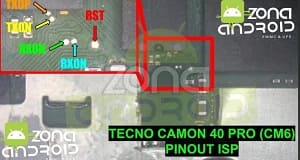ISP Pinout refers to a set of contact points on the mainboard of the Tecno Camon 40 Pro CM6, used for low-level firmware installing or recovery operations. These pins allow direct communication with the internal memory using specialized hardware tools such as UFI Box, JTAG, or other supported programming devices. By accessing these pins, technicians can perform tasks like unbricking, bypassing factory reset protection, or installing stock ROMs — all without removing the memory chip from the motherboard.
This interface is particularly useful when the device is bricked, stuck in bootloop, or not responding to regular installing methods like Fastboot or EDL. Connecting through the ISP pinout allows direct access to the storage, making it an essential method for deep-level recovery.
Common Programming Interfaces and Pinouts
- USB – The most widely used interface. USB pinouts include VCC, GND, D+, and D−. It is standard for firmware installing and ADB/Fastboot operations.
- UART – A serial communication interface. Typical pins include RX (Receive), TX (Transmit), VCC, and GND. Often used in debug environments.
- JTAG – A professional interface for debugging and programming embedded devices. It provides full access to the microcontroller via multiple signal pins.
- SWD (Serial Wire Debug) – A simplified two-wire alternative to JTAG, used mostly on ARM-based microcontrollers for development and repair.
How to Use the ISP Pinout on Tecno Camon 40 Pro CM6
- Identify the correct ISP pinout points on the Tecno Camon 40 Pro CM6 motherboard using a diagram or schematic.
- Use a supported installing tool such as UFI, JTAG, or Easy JTAG to plug in the pins to your PC.
- Carefully attach jumper wires or a test point adapter to the ISP pads.
- Launch your installing software and proceed with reading or writing firmware as required.
- Ensure a stable connection to avoid data corruption during the process.


